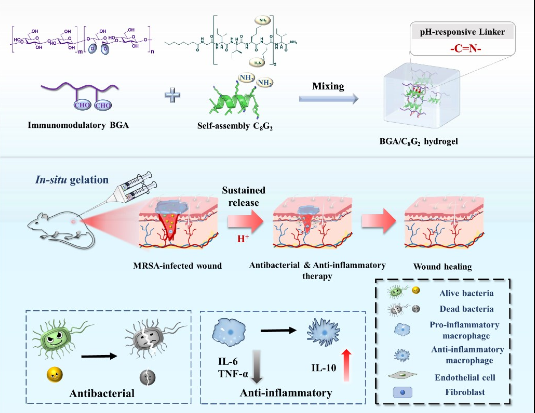Bacterial infections are one of the major contributing factors to human mortality, and it is estimated that one in four human deaths are due to diseases caused by bacterial infections. Inhibiting bacterial reproduction and growth through antibiotics is the main means of antibacterial treatment at present, but the abuse of antibiotics has led to the serious problem of Antimicrobial Resistance (AMR) and the occurrence of super drug-resistant bacteria, posing a severe threat to human health. Therefore, the development of non-antibiotic antimicrobial technologies is the key to subsequent treatment and reduction in the abuse of antibiotics. A simple, effective strategy with rich application scenarios is to develop multifunctional antimicrobial materials by combining antimicrobial active ingredients with biologically friendly carriers (such as hydrogels, microgels, etc.), which can achieve efficient drug delivery and minimize the occurrence of bacterial resistance and the toxic side effects of drugs. Based on this, with the financial support from the Key Project of NSFC Joint Fund for Promoting Cross-Strait Technological Cooperation, the NSF Youth Fund and so on, the bio-antimicrobial materials team, led by Prof. Zhu Hu, in collaboration with scholars at home and abroad, has developed a series of multifunctional responsive antimicrobial materials, and achieved remarkable innovative research results, which have great theoretical significance and application value for establishing therapeutic programs for drug-resistant bacterial infections and developing novel multifunctional bio-antimicrobial drugs. The results are also in line with the needs of our national drug development strategy. The results have been published in the top international authoritative SCI journals Journal of Controlled Release, ACS Applied Materials & Interface and Carbohydrate Polymers. The first authors are Li Li, a doctoral student, Associate Professor Wang Xuejiao, and Lecturer Chang Aiping, and the co-corresponding authors are Prof. Lv Jianren of the University of Manchester, Associate Professor Zhu An of Fujian Medical University, Associate Professor Wang Yinglu of FNU, and Prof. Zhu Hu of FNU, with FNU as the first signature unit.
Bacterial infections and excessive inflammation can impede the healing of wounds. Hydrogels have emerged as a promising approach for dressing bacterial-infected injuries. However, some antibacterial hydrogels are complex, costly, and even require assistance with other instruments such as infrared light, making them unsuitable for routine outdoor injuries. The work, entitled “An Additive-Free Multifunctional β-Glucan-Peptide Hydrogel Participates in the Whole Process of Bacterial-Infected Wound Healing”, was published in the top medical journal Journal of Controlled Release. The research reports an in-situ generating hydrogel constructed from oxidized β-D-glucan and an amphiphilic antimicrobial peptide. This hydrogel is easily accessible and actively contributes to the whole healing process of bacteria-infected wounds through antibacterial activity and and immunomodulatory activity inherent in the two-component system. The reversible imine bond enables the hydrogel to sustainably release the antibacterial peptide and inflammation-regulating β-D-glucan around the wound tissue, inhibiting the release of excessive inflammatory factors while promoting the release of anti-inflammatory factors, and thus accelerating wound healing. Meanwhile, the wetness and network structure inherent in the hydrogel make it capable of stopping bleeding and promoting cell migration. In methicillin-resistant Staphylococcus aureus (MRSA)-infected full-thickness skin wound models, the hydrogel showed superior antibacterial and anti-inflammatory activity, and expedited wound healing. The hydrogel also inhibited the expression of inflammatory factors and promoted the production of anti-inflammatory factors in vivo, while enhancing M2 macrophage polarization and accelerating epidermal tissue regeneration. These features make this hydrogel an appealing wound dressing for treating multi-drug-resistant bacteria-infected wounds.
Injured skin’s inability to prevent harmful bacteria from infiltrating tissues often leads to persistent wound infections and even more severe tissue damage. Herein, we developed a novel amphiphilic microgel with bi-functional domains, accelerating wound healing through synergizing photothermal antibacterial therapy with nitric oxide (NO) release. The research paper, titled “Cyclodextrin-modified amphiphilic microgel with bifunctional domains for infected wound healing via photothermal antibacterial therapy and nitric oxide release”, was published in the premier materials science journal ACS Applied Materials & Interfaces. This cyclodextrin-modified amphiphilic microgel features a 3D network structure that encapsulates both hydrophilic indocyanine green (ICG) as a trigger for photothermal therapy and hydrophobic BNN6 as a heat-sensitive NO donor to effectively fight bacterial infections via the synergistic chain reactions of light and heat. Meanwhile, experiments in vivo demonstrated the microgel promoted the formation of neovascularization and collagen fiber in wound areas as well as the elimination of inflammation cells, which offers a new avenue for inquiry to develop biologically functional materials that facilitate wound healing.
Skin injuries are one of the most prevalent medical problems. Wound dressings are materials used to cover a wound to protect it from further injuries, inhibit bacterial infection, and promote wound healing. Hydrogels, with their high water absorption capacity and similar physicochemical characteristics to that of human tissues, are considered by many researchers as the best choice for wound dressings. The research paper, titled “Citric acid crosslinked sphingan WL gum hydrogel films supported ciprofloxacin for potential wound dressing application”, was published in the top chemical journal Carbohydrate Polymers. In this study, citric acid (CA) crosslinked WL hydrogel films were firstly developed for potential wound dressing application. The results showed that the drug-loaded WL-based hydrogel films have PH-responsive swelling behavior, drug release properties, long-lasting antibacterial activity, and superior biocompatibility, with great potential applications in the field of medicine.
Paper links: https://www.sciencedirect.com/science/article/abs/pii/S0168365923005953
https://pubs.acs.org/doi/10.1021/acsami.3c02115
https://www.sciencedirect.com/science/article/abs/pii/S0144861722004258

(Translated by Huang Rui/ Reviewed by Xie Xiujuan)
